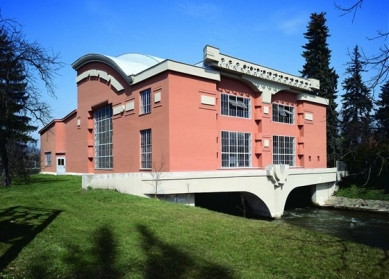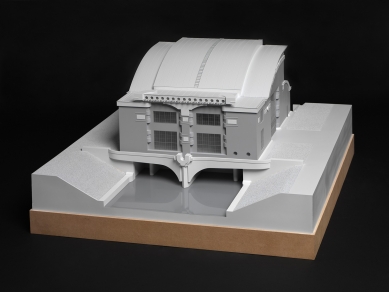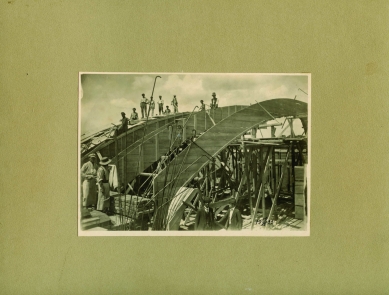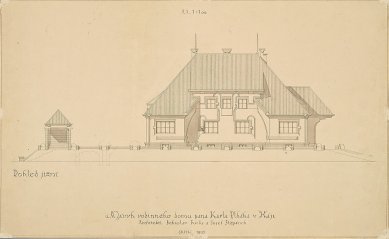
Pohnutá historie: Elektrárna a vila v Háji u Mohelnice - výstava v MUO
Pořadatel
Museum umění Olomouc
Místo konání
Denisova 824 /47, Olomouc
Start
fri 24.3.2023 10:00
End
sun 04.6.2023 18:00
vernissage
thu 23.3.2023 18:30
Odkaz
www.muo.cz/pribeh ...
Museum umění Olomouc
Místo konání
Denisova 824 /47, Olomouc
Start
fri 24.3.2023 10:00
End
sun 04.6.2023 18:00
vernissage
thu 23.3.2023 18:30
Odkaz
www.muo.cz/pribeh ...
Exhibitions
Czech Republic
Olomouc
Bohuslav Fuchs
Josef Štěpánek
Publisher
Tisková zpráva
Tisková zpráva
Remarkable fates of the Plhák family, who built a rondocubist villa and an architecturally interesting hydroelectric power plant in the settlement of Háj near Mohelnice a hundred years ago, bring the first exhibition of this year at the Museum of Art in Olomouc titled Disturbed History / Power Plant and Villa in Háj near Mohelnice. The exhibition, which starts at the Gallery of the Museum of Modern Art on March 23 at 18:30, is accompanied by a publication by Pavel Zatloukal What Buildings Tell. Power Plant and Villa in Háj near Mohelnice.
The mill in Háj has been mentioned in documents since the mid-14th century. The Plhák family acquired it in 1873 and at the turn of the century established the very first cooperative power plant in the entire Habsburg monarchy. After World War I, they turned to young architects Bohuslav Fuchs and Josef Štěpánek at the recommendation of Jan Kotěra, who designed not only a new power plant from 1920-1921 but also a one-story villa furnished with stylish furniture.
The concrete base of the power plant rises from a pillar that emerges from the intake, only to branch out abundantly shortly thereafter. Energy seems to rise from the water up to the crown of the building, where it is transmitted into the grid by the rays of electric wires. The rounded roof and arch motifs of the richly red building constantly remind of what is not visible from the outside – water falling and spinning the turbines.
In the villa, whose semicircular entrance directly pulls visitors inside, the most significant focus is in the entrance hall with a fireplace and an open staircase to the upper floor. The central element here is a sculpturally designed column – it not only delineates the staircase but also supports clusters of ceiling beams that also arch out. Symbolically, it thus supports the entire house. “It is the tree of life, drawing energy from the earth, nourishing and branching, connecting the entire organism of the building. Once again, we can think of the richly branched symbolism of energy transformation with a vitalistic tone,” notes Pavel Zatloukal. The garden surrounding the villa was gradually arranged as a park or even an arboretum. It seamlessly transitioned into the surrounding vast and picturesque meadows.
At the end of World War II, Karel Jr. – son of Karel and Ellen Plhák – became involved in the anti-Nazi resistance; in Háj, they also hid escaping Yugoslav, French, and Soviet prisoners of war. However, after liberation, the state first nationalized the power plant from the Plhák family, and subsequently, in a fabricated process in 1951, both Karel Sr. and his brother Radomír were imprisoned and sentenced to asset forfeiture. Karel Jr. emigrated to Canada as early as 1948.
After 1989, both buildings acquired new owners who undertook their exemplary reconstruction. The villa has been a protected monument since 1958, and the power plant was even classified among national cultural monuments in 2008.
The exhibition Disturbed History. Power Plant and Villa in Háj near Mohelnice presents a comprehensive collection of original planning and photographic documentation from both the museum's collections and the private collection of the Grohar couple, who also care for the remnants of the original artistic furnishings of the house. Valuable collections of rondocubist furniture are now preserved at the Silesian Museum in Opava and the Regional Museum in Šumperk. Additional photographs from the time of construction of the intake and the power plant were lent by the exhibition sponsor Jiří Krušina. The exhibition will also feature family film footage provided by the family of Soňa Jelínková, the last witness of the beautiful times in Háj. The period documentation is accompanied by the latest collection of photographs by Markéta Lehečková devoted to architecture and lyrical landscapes of the surroundings.
EXHIBITION: Disturbed History. Power Plant and Villa in Háj near Mohelnice
OPENING: March 23, 2023, at 18:30
DURATION: until June 4, 2023
PLACE: Museum of Modern Art, Gallery
AUTHORS: Pavel Zatloukal, Martina Mertová, and Klára Jeništová
CURATORS: Klára Jeništová, Martina Mertová
GRAPHIC DESIGN: Vladimír Vaca, publikum.design
LENDERS: Miroslava and Ondřej Grohar, Jiří Krušina, Soňa Štěrbová, Silesian Museum, Regional Museum in Šumperk, National Technical Museum
The mill in Háj has been mentioned in documents since the mid-14th century. The Plhák family acquired it in 1873 and at the turn of the century established the very first cooperative power plant in the entire Habsburg monarchy. After World War I, they turned to young architects Bohuslav Fuchs and Josef Štěpánek at the recommendation of Jan Kotěra, who designed not only a new power plant from 1920-1921 but also a one-story villa furnished with stylish furniture.
The concrete base of the power plant rises from a pillar that emerges from the intake, only to branch out abundantly shortly thereafter. Energy seems to rise from the water up to the crown of the building, where it is transmitted into the grid by the rays of electric wires. The rounded roof and arch motifs of the richly red building constantly remind of what is not visible from the outside – water falling and spinning the turbines.
In the villa, whose semicircular entrance directly pulls visitors inside, the most significant focus is in the entrance hall with a fireplace and an open staircase to the upper floor. The central element here is a sculpturally designed column – it not only delineates the staircase but also supports clusters of ceiling beams that also arch out. Symbolically, it thus supports the entire house. “It is the tree of life, drawing energy from the earth, nourishing and branching, connecting the entire organism of the building. Once again, we can think of the richly branched symbolism of energy transformation with a vitalistic tone,” notes Pavel Zatloukal. The garden surrounding the villa was gradually arranged as a park or even an arboretum. It seamlessly transitioned into the surrounding vast and picturesque meadows.
At the end of World War II, Karel Jr. – son of Karel and Ellen Plhák – became involved in the anti-Nazi resistance; in Háj, they also hid escaping Yugoslav, French, and Soviet prisoners of war. However, after liberation, the state first nationalized the power plant from the Plhák family, and subsequently, in a fabricated process in 1951, both Karel Sr. and his brother Radomír were imprisoned and sentenced to asset forfeiture. Karel Jr. emigrated to Canada as early as 1948.
After 1989, both buildings acquired new owners who undertook their exemplary reconstruction. The villa has been a protected monument since 1958, and the power plant was even classified among national cultural monuments in 2008.
The exhibition Disturbed History. Power Plant and Villa in Háj near Mohelnice presents a comprehensive collection of original planning and photographic documentation from both the museum's collections and the private collection of the Grohar couple, who also care for the remnants of the original artistic furnishings of the house. Valuable collections of rondocubist furniture are now preserved at the Silesian Museum in Opava and the Regional Museum in Šumperk. Additional photographs from the time of construction of the intake and the power plant were lent by the exhibition sponsor Jiří Krušina. The exhibition will also feature family film footage provided by the family of Soňa Jelínková, the last witness of the beautiful times in Háj. The period documentation is accompanied by the latest collection of photographs by Markéta Lehečková devoted to architecture and lyrical landscapes of the surroundings.
EXHIBITION: Disturbed History. Power Plant and Villa in Háj near Mohelnice
OPENING: March 23, 2023, at 18:30
DURATION: until June 4, 2023
PLACE: Museum of Modern Art, Gallery
AUTHORS: Pavel Zatloukal, Martina Mertová, and Klára Jeništová
CURATORS: Klára Jeništová, Martina Mertová
GRAPHIC DESIGN: Vladimír Vaca, publikum.design
LENDERS: Miroslava and Ondřej Grohar, Jiří Krušina, Soňa Štěrbová, Silesian Museum, Regional Museum in Šumperk, National Technical Museum
The English translation is powered by AI tool. Switch to Czech to view the original text source.





0 comments
add comment










